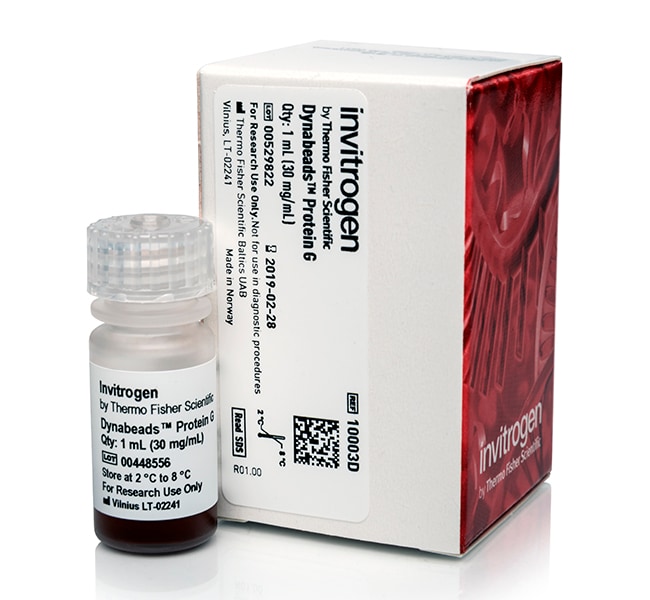La proteína G Dynabeads son gránulos superparamagnéticos uniformes de 2,8 μm con proteína G recombinante (∼17 kDa) unida covalentemente a la superficie. La proteína G Dynabeads ofrece una alternativa superior a la Sepharose o la agarosa para la inmunoprecipitación (IP), y se dispone de protocolos manuales y automatizados.
• IP en menos de 40 minutos
• Alto rendimiento de proteínas objetivo con bajo consumo de anticuerpos
• Unión no específica muy baja con alta relación señal-ruido
• Sin necesidad de columnas, centrifugaciones ni larga limpieza previa
• Alta reproducibilidad y alto rendimiento compatible con instrumentos KingFisher
La separación manual de Dynabeads es rápida y fácil de realizarEl protocolo manual es sencillo y se puede realizar en menos de 40 minutos. En primer lugar, el anticuerpo de la proteína objetivo se incuba con la proteína G Dynabeads en un tubo durante 10 minutos. El exceso de anticuerpo se elimina colocando el tubo en un imán DynaMag y eliminando el sobrenadante. Los gránulos recubiertos de anticuerpos se pueden utilizar para una variedad de aplicaciones posteriores, como IP, Co-IP, IP de cromatina (ChIP), IP de ARN (RIP), purificación de IgG a pequeña escala y purificación de proteínas. El material unido se recopila fácilmente en un imán DynaMag gracias a las exclusivas propiedades magnéticas de Dynabeads. La proteína G recombinante de los gránulos no contiene puntos de unión de albúmina, por lo que la albúmina no se copurifica durante el procedimiento. El IP es rápido y ofrece un alto rendimiento, una alta reproducibilidad y una unión no específica muy baja, por lo que no es necesario realizar una limpieza previa.
La separación automatizada de Dynabeads ayuda a aumentar el rendimiento y reduce el tiempo de manipulaciónSi está trabajando con varias muestras en paralelo, el número de pasos de lavado y el tiempo de manipulación aumenta proporcionalmente con el número de muestras. El pipeteo y otras manipulaciones manuales tienden a ser menos uniformes que la automatización cuando se trabaja con muchas muestras a la vez. Para manejar mejor un número de muestras de medio a alto rendimiento, reducir el tiempo de manipulación y asegurar una alta reproducibilidad, hemos desarrollado protocolos IP para los instrumentos KingFisher Flex y KingFisher Duo Prime. Los protocolos automatizados replican los protocolos manuales, que proporcionan un rendimiento proteico objetivo igual de alto y la misma unión no específica baja y alta reproducibilidad. No importa si está trabajando con 10 o 96 muestras, el protocolo IP es inferior a 40 minutos, independientemente. Solo tiene que cargar los reactivos en las placas, pulsar el botón de “inicio” y, para cuando haya preparado el análisis posterior, la IP estará lista. Es posible que sea necesaria cierta optimización (por ejemplo, los tiempos de incubación) dependiendo de su anticuerpo y de la abundancia y/o especificidad de su proteína objetivo.
• Utilice el instrumento KingFisher Duo para un rendimiento bajo a medio (1-12 muestras/ciclo)
• Utilice el instrumento KingFisher Flex para un rendimiento alto (12-96 muestras/ciclo)
Ver protocolos automatizadosVer un vídeo sobre el instrumento KingFisher FlexLa separación suave provoca un estrés físico mínimo en las proteínasLa tecnología de separación magnética que utiliza la proteína G Dynabeads es rápida y suave, de forma que causa el mínimo estrés físico en las proteínas objetivo. Esto permite el aislamiento y la concentración de compuestos lábiles que, de otro modo, podrían disociarse o quedar dañados por las proteasas durante largos tiempos de incubación. Se preserva la conformación de proteínas nativas y los grandes complejos de proteínas.
Fuerza y capacidad de uniónLa proteína G Dynabeads permite el aislamiento de la mayoría de las inmunoglobulinas de mamíferos (Ig). La cantidad de Ig capturada depende de la concentración de Ig en la muestra inicial, así como del tipo y la fuente de Ig. 100 μl de proteína G Dynabeads aislarán aproximadamente 25–30 μg de IgG humana a partir de una muestra que contiene 20–200 μg/ml de IgG. La unión Fc predominante permite una orientación de Ig óptima. Los anticuerpos se unen a la superficie lisa exterior de los gránulos, de modo que no quedan atrapados en poros grandes, como sucede con los gránulos basados en Sepharose/agarosa. Todos los anticuerpos están disponibles para la unión de proteínas, por lo que se requieren cantidades bajas de anticuerpos mientras se sigue obteniendo el mismo alto rendimiento de la proteína diana. La superficie lisa del gránulo también es responsable de la unión baja no específica por la que son conocidos los Dynabeads.
Obtenga más información acerca de Dynabeads•La Proteína A Dynabeads también está disponible como
un kit listo para usar con tampones incluidos
•
Ver guías de selección de inmunoprecipitación, datos y referencias•
Ver imanes para separaciones de Dynabeads
•
Buscar productos Dynabeads para otras aplicacionesComprar en OEMPara comprar Proteína A y Proteína G Dynabeads en un OEM, póngase en contacto con nuestro departamento de ventas de OEM y de licencias de productos.
*Sepharose es una marca comercial de GE Healthcare Bio-Sciences AB.
